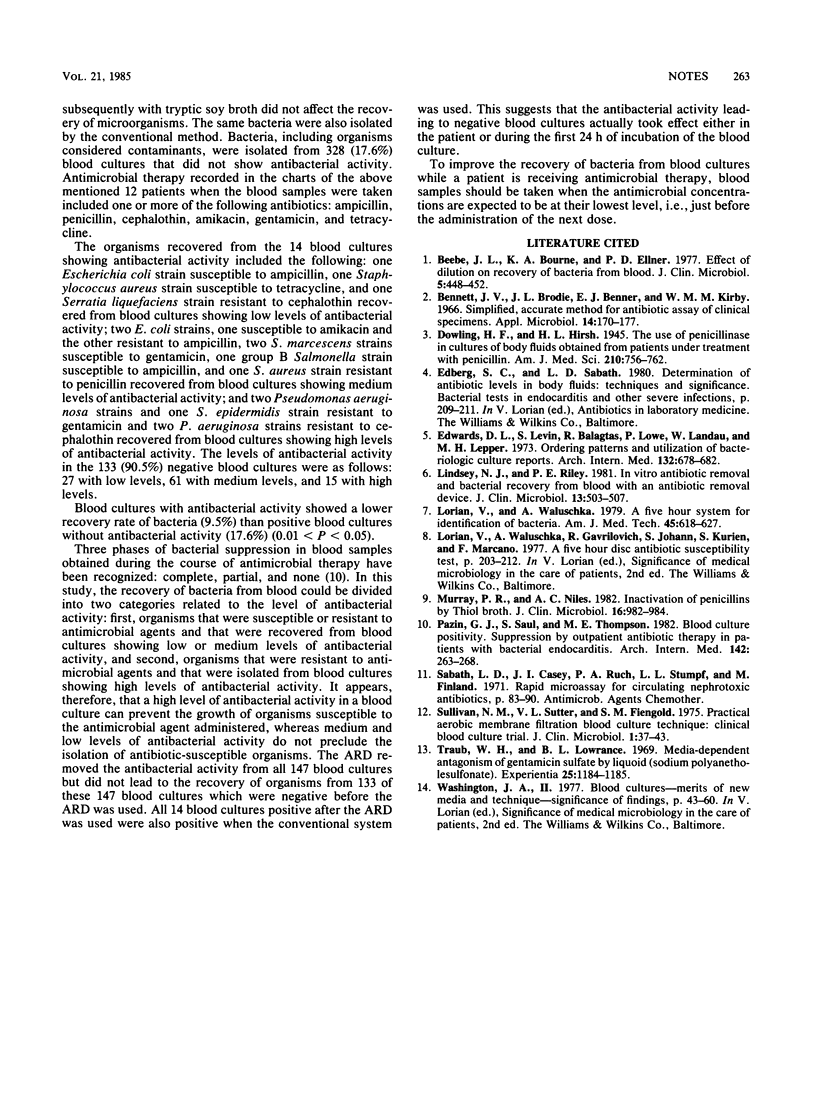Abstract
A total of 2,010 blood samples inoculated into tryptic soy broth were examined for antibacterial activity by means of a bioassay plate seeded with Bacillus subtilis spores. The size of the zone of inhibition on this plate was indicative of the degree of antibacterial activity. Current antibiotic therapy was confirmed by examination of chart records. Of the 2,010 blood cultures tested, 147 (7.3%) contained detectable levels of antibiotics; of these 147, 14 (9.5%) yielded growth of bacteria, and 133 (90.5%) remained negative. When the Antibiotic Removal Device (Marion Scientific, Div. Marion Laboratories, Inc., Kansas City, Mo.) was used, it eliminated the antibacterial activity but did not improve the recovery of bacteria from these cultures. Only bacteria resistant to the respective antibiotic were recovered from blood cultures that showed high levels of antibacterial activity (beta-lactam antibiotics, greater than 0.60 micrograms/ml; aminoglycosides, greater than 2 micrograms/ml; and tetracycline, greater than 4 micrograms/ml). Blood cultures showing low levels of antibacterial activity yielded both resistant and susceptible bacteria.
Full text
PDF

Selected References
These references are in PubMed. This may not be the complete list of references from this article.
- Beebe J. L., Bourne K. A., Ellner P. D. Effect of dilution on recovery of bacteria from blood. J Clin Microbiol. 1977 Apr;5(4):448–452. doi: 10.1128/jcm.5.4.448-452.1977. [DOI] [PMC free article] [PubMed] [Google Scholar]
- Bennett J. V., Brodie J. L., Benner E. J., Kirby W. M. Simplified, accurate method for antibiotic assay of clinical specimens. Appl Microbiol. 1966 Mar;14(2):170–177. doi: 10.1128/am.14.2.170-177.1966. [DOI] [PMC free article] [PubMed] [Google Scholar]
- Edwards L. D., Levin S., Balagtas R., Lowe P., Landau W., Lepper M. H. Ordering patterns and utilization of bacteriologic culture reports. Arch Intern Med. 1973 Nov;132(5):678–682. [PubMed] [Google Scholar]
- Lindsey N. J., Riely P. E. In vitro antibiotic removal and bacterial recovery from blood with an antibiotic removal device. J Clin Microbiol. 1981 Mar;13(3):503–507. doi: 10.1128/jcm.13.3.503-507.1981. [DOI] [PMC free article] [PubMed] [Google Scholar]
- Lorian V., Waluschka A. A five-hour system for identification of bacteria. Am J Med Technol. 1979 Jul;45(7):618–627. [PubMed] [Google Scholar]
- Murray P. R., Niles A. C. Inactivation of penicillins by Thiol broth. J Clin Microbiol. 1982 Nov;16(5):982–984. doi: 10.1128/jcm.16.5.982-984.1982. [DOI] [PMC free article] [PubMed] [Google Scholar]
- Pazin G. J., Saul S., Thompson M. E. Blood culture positivity: suppression by outpatient antibiotic therapy in patients with bacterial endocarditis. Arch Intern Med. 1982 Feb;142(2):263–268. [PubMed] [Google Scholar]
- Sullivan N. M., Sutter V. L., Finegold S. M. Practical aerobic membrane filtration blood culture technique: clinical blood culture trial. J Clin Microbiol. 1975 Jan;1(1):37–43. doi: 10.1128/jcm.1.1.37-43.1975. [DOI] [PMC free article] [PubMed] [Google Scholar]
- Traub W. H., Lowrance B. L. Media-dependent antagonism of gentamicin sulfate by Liquoid (sodium polyanetholsulfonate). Experientia. 1969 Nov 15;25(11):1184–1185. doi: 10.1007/BF01900265. [DOI] [PubMed] [Google Scholar]


